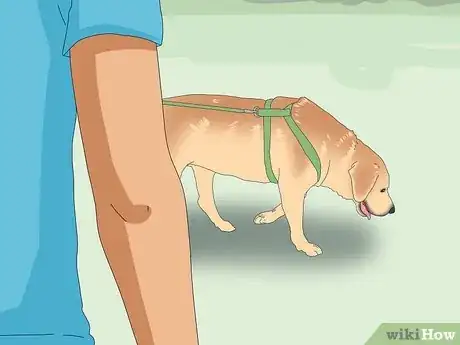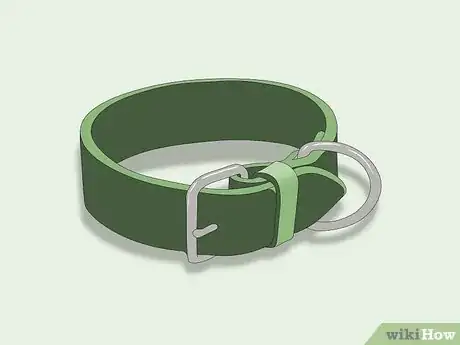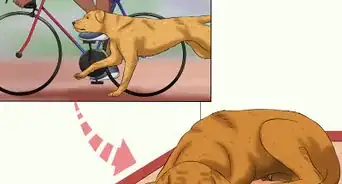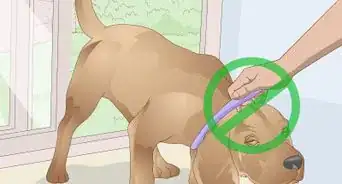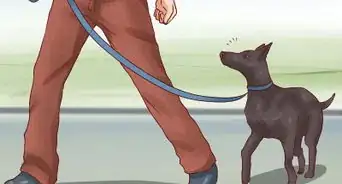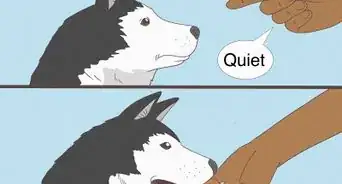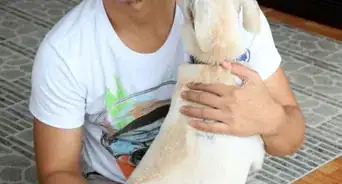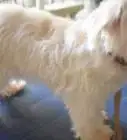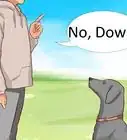This article was co-authored by Elisabeth Weiss. Elisabeth Weiss is a Professional Dog Trainer and owner of Dog Relations NYC, a dog training service in New York, New York. Elisabeth relies on science-based, force-free, and reward-based techniques. Elisabeth offers behavior training, puppy manners, body awareness and injury prevention, diet, exercise and dog nutrition services. Her work has been featured in New York Magazine and on the Dog Save the People podcast. She also trained all the dogs in the movie "Heart of a Dog" by Laurie Anderson that features Elisabeth's journey with Laurie Anderson's and Lou Reed's dog Lolabelle and how her passion for playing the keyboards played a significant role in improving her quality of life after being diagnosed with pancreatic cancer.
wikiHow marks an article as reader-approved once it receives enough positive feedback. In this case, 100% of readers who voted found the article helpful, earning it our reader-approved status.
This article has been viewed 461,156 times.
Many times when people take their dog for a walk, they are actually dragged along behind the dog, instead of leading them. A dog that pulls, or even a dog that lags behind, has not been properly trained to walk in unison with their owner. Heeling is such a comfortable way to walk with your dog, not against them, that it is worth your while to teach your pup how to do it. Anyone can train a dog to heel with repetition and patience, along with some simple techniques.
Steps
Learning How to Train Your Dog
-
1Find a quiet place to train your dog. You want to eliminate distractions so that your dog can concentrate on you easily. If you have a backyard, that is the perfect place to train your dog. Otherwise, find a quiet corner of a park with few other people or pets. If outdoors is too distracting, start inside. Gradually increase the amount of distraction as the dog learns, and be sure to practice in different places so that the dog understands that "heel" means "heel" everywhere, not just in the backyard.
-
2Teach the dog to watch you. This can be accomplished by simply associating a cue such as "Watch me" with a treat. Your dog will quickly learn to look at you when you use the word, as they will expect a treat. Once this has been accomplished, give treats randomly, not necessarily for every occasion, but don't stop completely.
- Don't rely on the leash to physically move the dog. The leash is for safety, not a means of communication. Practicing off-leash in a safe location is ideal.
Advertisement -
3Choose a release cue such as "okay", "free", or "break" to communicate to the dog that it's okay to break heel position or get up from a sit.
Training Your Dog to Heel With Positive Reinforcement
-
1Teach your dog proper positioning. The proper way to walk a dog is with the dog on your left side. However, this is only necessary for formal obedience and some other sports. For pet dogs, choose whichever side is best for you, but be consistent and stick with the chosen side.
- The dog should walk with their head or shoulder even with your hip.
- You are not holding the leash tight to keep your dog in place. The leash is slack between you, with no contact.
-
2Teach your dog to position itself correctly. "Right Here" is a useful command to teach your dog when standing. If your dog is not close enough or is confused about which side to sit at, slap your hip and use the command "Right Here". If needed, lure your dog to your side with a treat. As your dog learns, slowly fade the lure by using your hand without a treat, then just your hand, then more general. The lure can become a hand signal (moving your hand to your hip).
-
3Create a training spot for your dog. For instance, you might use a platform or mat. When the dog interacts with the platform, put yourself in heel position by standing just to the right of the dog, then reward them with a valuable treat. Most dogs will quickly learn that you're rewarding their position next to you. Then, release the dog and reward them if they come back to the same position.[1]
- As your dog gets comfortable with this, make it more comfortable by changing your angle a little. Reward the dog when they come back to this position on their own.[2]
- Once the dog will heel when you're standing still, move to walking. It can help to walk the dog with a wall on the other side of them so they can't stray too far.[3]
-
4Get your dog's attention. The key to heeling is having your dog's attention. Start standing still with your dog sitting beside you in the correct position. Get your dog's attention by calling their name, tapping on their head, making noises, or using your pre-taught "watch me" cue.
- When the dog looks up, slap your left hip with your hand and say "Right Here". This is a command. Your dog can learn to look where you indicate, and in this way, you are giving your dog a reference point for where they should be while heeling.
- Set your dog up for success. Try your best to avoid asking for more than your dog is capable of.
- Remember, the key is getting your dog's attention. This can be the most difficult thing. Also, though it takes some work, you can teach your dog to look at you when you say "Watch me" or whatever your chosen cue is. Remember to reward with a treat when your dog responds correctly.
-
5With your dog in position, take one step. Reward your dog. Increase to two, then three, and so on.
-
6Once your dog is reliably heeling, introduce speed changes and turns.
- Consider every walk you have with the dog a training session.[4]
-
7Heavily reinforce your dog for good behavior with whatever they enjoy most - treats, play, petting, praise, etc. Treats are usually the most favoured and easiest option. You should positively reinforce your dog when they obey your commands correctly. Avoid using punishment to train.
Using Corrective Methods
-
1Use corrections with care. Many people train their dogs with all positive, reward-based methods, which require a lot of patience and consistency. Corrections can get quicker results sometimes, but it can also backfire by damaging your relationship with your dog, creating anxiety and confusion in the dog, and resulting in more unwanted behavior.
-
2Think of the leash as an extension of your arm. With this in mind, do not correct your dog unless they need correction. Giving mixed signals to your dog will only complicate and inhibit successful training.
- Keeping the leash slack (not correcting constantly) means that when you actually do pull on the leash, your dog is much more likely to listen to you.
-
3When you praise your dog, do not let them disobey your command until you release it. For instance, if you tell your dog to sit, it obeys, you praise it, and it gets up, immediately stop the praise. If your dog does not sit down again by itself after a few seconds, firmly put it into place, then praise again.
- You do not need to repeat the command. Enforcing it is much more effective. You may want to give the dog another chance to obey properly.
-
4Reinforce that your dog cannot forge ahead. Most dogs forge ahead. To correct this, keep your dog on a leash that is tight enough to allow you to step across in front of them. When they try to forge ahead, turn sharply and step directly in their path, making a 90-degree turn and heading off in a new direction. Once again, turn sharply, as if walking along a square.
- The dog will be used to leading you, and may be surprised or confused. Walk in a straight line again, until the dog tries to forge past you. Pull the same stunt. Doing this for 5-15 minutes a day is enough. Some dogs learn after the first session, but some dogs who have been used to leading you for years may take longer.
-
5Train your dog not to lag as well. Most dogs lag consistently if they feel afraid, neglected, unwanted, or abused but many dogs lag occasionally if they are sidetracked by smells or activities. The way to stop lagging is similar to stopping forging. All you have to do is let the leash hit your leg every time you step as you walk.
- Your leash should once again be in your right hand, and a lagging dog would be on your left side behind you, with the leash crossing in front of your legs. This will cause a jerk when you step forward with your left leg, and if this isn't enough to make your dog want to catch up, you can slowly reel in the leash while your leg is bumping it.
- You should use a command while doing this "Get-Up-Here" and/or "Right Here"; with your left hand slap your hip. Speak this command, and your dog's name, using "Hey" to get his attention if needed. Once your dog is next to you, praise and let the leash slack. Most likely they will lag again, but all you have to do is repeat.
-
6Try placing your thumb in your pocket to secure the lead at a length you feel comfortable working with. The abrupt stop or changes in direction at the consistent lead tension seem to direct the dog well. Sometimes with your hands free you can tend to allow too much slack allowing the dog to roam while you daydream. The thumb trick keeps them firmly in place.
-
7Use a thick collar. Thinner collars are more severe than wider collars, as pressure is not displaced over a larger area, making corrections more severe.
Expert Q&A
-
QuestionHow do you teach a dog without it getting frustrated?
 Elisabeth WeissElisabeth Weiss is a Professional Dog Trainer and owner of Dog Relations NYC, a dog training service in New York, New York. Elisabeth relies on science-based, force-free, and reward-based techniques. Elisabeth offers behavior training, puppy manners, body awareness and injury prevention, diet, exercise and dog nutrition services. Her work has been featured in New York Magazine and on the Dog Save the People podcast. She also trained all the dogs in the movie "Heart of a Dog" by Laurie Anderson that features Elisabeth's journey with Laurie Anderson's and Lou Reed's dog Lolabelle and how her passion for playing the keyboards played a significant role in improving her quality of life after being diagnosed with pancreatic cancer.
Elisabeth WeissElisabeth Weiss is a Professional Dog Trainer and owner of Dog Relations NYC, a dog training service in New York, New York. Elisabeth relies on science-based, force-free, and reward-based techniques. Elisabeth offers behavior training, puppy manners, body awareness and injury prevention, diet, exercise and dog nutrition services. Her work has been featured in New York Magazine and on the Dog Save the People podcast. She also trained all the dogs in the movie "Heart of a Dog" by Laurie Anderson that features Elisabeth's journey with Laurie Anderson's and Lou Reed's dog Lolabelle and how her passion for playing the keyboards played a significant role in improving her quality of life after being diagnosed with pancreatic cancer.
Professional Dog Trainer Keep your training sessions short so your dog doesn't get frustrated or discouraged.
Keep your training sessions short so your dog doesn't get frustrated or discouraged. -
QuestionHow do you train a dog to walk with you?
 Pippa Elliott, MRCVSDr. Elliott, BVMS, MRCVS is a veterinarian with over 30 years of experience in veterinary surgery and companion animal practice. She graduated from the University of Glasgow in 1987 with a degree in veterinary medicine and surgery. She has worked at the same animal clinic in her hometown for over 20 years.
Pippa Elliott, MRCVSDr. Elliott, BVMS, MRCVS is a veterinarian with over 30 years of experience in veterinary surgery and companion animal practice. She graduated from the University of Glasgow in 1987 with a degree in veterinary medicine and surgery. She has worked at the same animal clinic in her hometown for over 20 years.
Veterinarian A neat way is to reward the dog when he sits spontaneously. Start training in a safe place off leash. Hold a treat but ignore the dog. He gets the treat only when he sits. Let him fuss and jump around, but don't direct him. Wait for him to sit to think things through, at which point praise and reward him. Now, take a couple of steps forward and stop again. Wait for him to finish fooling around and sit. Reward him. Then set off again. The dog will quickly learn to sit when you stop. Use this to have the dog walk beside you, because every time he surges ahead, you simply stop and have him sit.
A neat way is to reward the dog when he sits spontaneously. Start training in a safe place off leash. Hold a treat but ignore the dog. He gets the treat only when he sits. Let him fuss and jump around, but don't direct him. Wait for him to sit to think things through, at which point praise and reward him. Now, take a couple of steps forward and stop again. Wait for him to finish fooling around and sit. Reward him. Then set off again. The dog will quickly learn to sit when you stop. Use this to have the dog walk beside you, because every time he surges ahead, you simply stop and have him sit. -
QuestionHow do I get my dog to stop pulling on the leash?
 Pippa Elliott, MRCVSDr. Elliott, BVMS, MRCVS is a veterinarian with over 30 years of experience in veterinary surgery and companion animal practice. She graduated from the University of Glasgow in 1987 with a degree in veterinary medicine and surgery. She has worked at the same animal clinic in her hometown for over 20 years.
Pippa Elliott, MRCVSDr. Elliott, BVMS, MRCVS is a veterinarian with over 30 years of experience in veterinary surgery and companion animal practice. She graduated from the University of Glasgow in 1987 with a degree in veterinary medicine and surgery. She has worked at the same animal clinic in her hometown for over 20 years.
Veterinarian Try the stop-start method. A dog pulls because they feel it gets them where they want to go more quickly. When the dog pulls, stop. Only start moving forward again when the leash goes slack. It helps to make a disapproving noise such as "Uh-oh" just before the leash goes taut. This signals to the dog you are about to stop, and gives them the option to slow up instead of having you stop. If the dog then slackens the pace, praise them.
Try the stop-start method. A dog pulls because they feel it gets them where they want to go more quickly. When the dog pulls, stop. Only start moving forward again when the leash goes slack. It helps to make a disapproving noise such as "Uh-oh" just before the leash goes taut. This signals to the dog you are about to stop, and gives them the option to slow up instead of having you stop. If the dog then slackens the pace, praise them.
Warnings
- Be in control of your dog at all times and remind others with dogs that they should too. Please keep in mind that no matter how much you love your dog, and how gentle you know he is, do not let yourself and your dog get into a dangerous situation. Protect your dog, yourself, and others by keeping your dog leashed and remembering that you are in charge of keeping your dog and others safe.⧼thumbs_response⧽
References
- ↑ Elisabeth Weiss. Professional Dog Trainer. Expert Interview. 3 September 2020.
- ↑ Elisabeth Weiss. Professional Dog Trainer. Expert Interview. 3 September 2020.
- ↑ Elisabeth Weiss. Professional Dog Trainer. Expert Interview. 3 September 2020.
- ↑ https://www.aspca.org/pet-care/virtual-pet-behaviorist/dog-behavior/teaching-your-dog-not-pull-leash
- ↑ https://www.aspca.org/pet-care/virtual-pet-behaviorist/dog-behavior/teaching-your-dog-not-pull-leash
About This Article
To teach your dog to heel, choose a verbal command, such as "Right here," and use it consistently during training. Next, have your dog stand next to you, say the command, and show your dog the heel position. Then, take a step or two, repeat the command, and put your dog into the heel position again. Repeat this process, increasing the amount of steps you take each time and rewarding your dog with a treat when it responds correctly without your assistance. Spend a few minutes training your dog every day until the behavior sticks! For tips on using a leash during training, read on!















